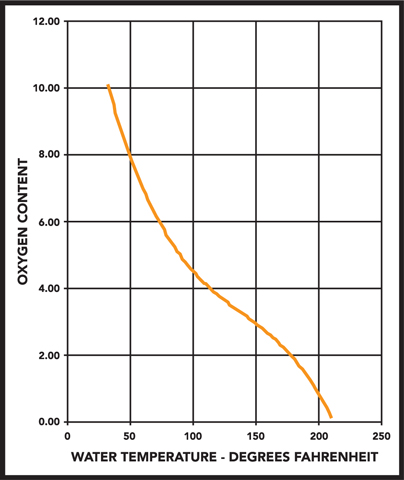
WHY DEAERATE?
HOW?

Figure
2. The effect of partial gas pressure and heating.
Complete gas removal. Adequate steam must be passed through the water to scrub out and carry away the gases after release. Extremely low partial gas pressure must be maintained since Henry’s Law states that the amount of gas which will dissolve in a liquid is proportional to the partial gas pressure in the atmosphere contacting the liquid. It is mandatory that the volume of scrubbing steam be high to produce the low partial gas pressure, and it is equally mandatory that these conditions prevail throughout the deaerating section. The effect of partial gas pressure and heating is illustrated in Figure 2.
DEAERATOR TYPES
There are five principle types of deaerators: parallel flow tray, counterflow tray, scrubber spray, atomizing spray, and cold water. All designs employ the cardinal principles of deaeration outlined above and are capable of delivering water with a dissolved oxygen removal to ensure the effluent contains 7 ppb or less.Tray deaerators. Tray (or spray-tray) units are most widely used for deaerating boiler feedwater in industrial plants and central generating stations. Water is heated to full saturation temperature with minimum pressure drop and minimum vent, thereby ensuring best thermal efficiency. Deaeration is accomplished by spreading the water over multiple layers of trays designed to break the water into thin films and drops to promote intimate contact with the scrubbing steam. Parallel downflow designs provide maximum flexibility for application, and it will handle any combination of condensate and makeup. Counterflow designs provide best economy for plants having low makeup requirements (higher condensate return percentage).
Spray-deaerators. These are widely used in industrial plants where treated water makeup is dominant over condensate returns. The most common spray deaerator features a scrubbing device where steam and water are mixed to provide the contact and agitation necessary for a high level of dissolved oxygen reduction. “Scrubber” deaerators are simple and economical with low maintenance but do not perform well at reduced loads. The “atomizing” variation of the spray deaerator was developed for use in marine vessels to accommodate low load operation and are an option to the scrubber-type designs when high load-turndown capability is needed. Atomizing deaerators use an internal valve that varies the steam injection opening to suit the load where the fixed openings used in scrubber type units do not have this ability. Because the atomizing device has moving parts, it adds to the cost and requires more maintenance effort than the scrubber type design.
Cold water deaerators. Cold water deaerators are used primarily to eliminate corrosive gases from cooling water or water used in food processing, where it would be undesirable to increase the water temperature or risk contamination due to contact with the volatile chemicals present in the usual steam supply.
To replace the addition of steam that is characteristic of the usual tray and spray deaerators, a boiling condition is created in a cold water deaerator by pressure reduction using vacuum-producing equipment. Surface contact with scrubbing vapor and agitation is provided by a column of mass transfer packing in lieu of trays, scrubbers, or atomizing devices.
CONCLUSION
The benefits of deaeration of boiler feed and process water has become so well recognized that even small plants now ensure longer equipment life and reduced maintenance by employing some type of deaeration.Deaeration today is an important factor in the successful and economical operation of any modern boiler plant, regardless of its size. TB




